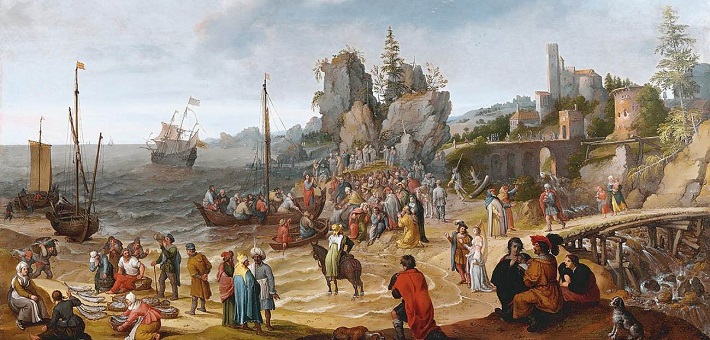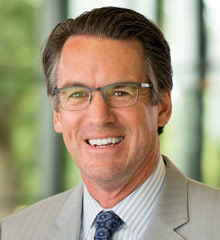Commentary on Mark 6:30-34, 53-56
So much for subtlety and secrets.
Jesus has a way of attracting attention and drawing crowds. It can be easy to miss that because so many of the prominent passages in Mark involve him interacting with individuals who need healing or disciples who need a clue. In this reading, which is artificially created by combining two short, summary-style paragraphs and leaving out two more dramatic stories (6:35–52), Mark emphasizes just how popular Jesus grows in the communities around the Sea of Galilee.1
The passage begins by directing attention to Mark’s narrative structure. The disciples who extended Jesus’ ministry of preaching, exorcism, and healing two Sundays ago (6:7–13) have returned. Presumably their ministry conducted with Jesus’ authority adds to his growing reputation in the region. The story of John’s execution last Sunday (6:14–29) ought to remind us of the danger still lurking on the political landscape. Getting away for a while therefore sounds like a good idea for Jesus and his followers for many reasons, but there’s never an escape from the suffering of the world.
Mark does not disclose Jesus’ anticipated destination; that matters less than the detail that people travel swiftly to beat him there. You’d swarm him and interrupt his retreat, too, if you were both desperate and convinced that he could provide relief.
Nothing suggests that Jesus experiences frustration with the masses and their insistence. He feels compassion, a deep sympathy rumbling in his viscera. (Your congregation might be delighted to learn to pronounce the verb splagchnizomai, which indicates compassion; see also 1:41; 8:2.) His response involves more than a warm and sensitive heart. These people are being denied well-being and justice, and the offense seizes Jesus. Mark signals that by likening the people to “sheep without a shepherd” (verse 34).
The Bible often compares leaders to shepherds (for example, Numbers 27:17; 2 Chronicles 18:16). “The system” has failed the people who flock to Jesus, as evidenced in Herod Antipas’s lethal fecklessness (6:14–29).2 They are vulnerable in a predatory world. No one, it seems, guards their human dignity. They have to fend for themselves. What kind of society places people in that kind of condition?
Later, after another trip on the lake, Jesus comes ashore and again experiences the consequences of being “recognized” (verses 33, 54). Like a powerful magnet, he draws to himself people who suffer ailments and heals them, no matter where he is.
Mark notes that third parties play a part in the healings as well. Twice the narrative mentions the people who bring those who are sick to Jesus. We can use our imagination: family, friends, maybe even concerned strangers play a part in making sure that people have access to Jesus and the healthcare he freely offers. Mark makes no explicit claim that everyone who encounters Jesus receives healing, only those who touch his garment (see also 5:27–29), but obviously the implication is that he heals all. What a blessing it is when people get those who need help to the one who can help.
If Jesus was ever serious about thinking he could keep his power a secret, by now it is clear that he was quite misguided (see 1:43–45; 3:12; 5:43). People who experience healing, nourishment, and hope often have a hard time keeping quiet about it. Remember that Mark has so far revealed very little about what Jesus teaches people. His reputation as a wonderworker is magnificent.
This passage offers preachers an opportunity to reflect on the gospel’s relationship to health and wholeness. When Jesus heals people of their ailments, his acts are not symbolic of the salvation he provides. They are a piece of that salvation. We miss that when we make “salvation” into an otherworldly concept or a primarily spiritual condition.3 Jesus devotes himself to ensuring human flourishing in body, mind, spirit, and community. So, too, should any church that conducts ministry in his name and in the power of the same Holy Spirit that indwells him.
At the same time, Jesus’ ministry does not totally eliminate the things that assail our well-being. The people Jesus heals, we presume, get sick again and die. Jesus is a healer, yes, but his purpose entails more than spreading temporary wellness.
Healing stories present a challenge because they often lend themselves to ableist interpretations. Some of those interpretations operate under presumptions that ailments and diseases create defective bodies in contrast to “normal” or “healthy” human beings. They thus promote a certain kind of embodied ideal as what it means to be holy, blessed, or whole. Those ideals disparagingly associate disability or unhealth with sinfulness.
Other harmful interpretations insist that faith must be the precursor or cause of healing. They can lead us to attribute ongoing illness (or the onset of an illness) to a person’s lack of sufficient faith. (Note that this passage contains no mention of “faith” in connection with the people who are healed or the people who facilitate healing. Presumably folks believe that Jesus can heal them. That might be the sum of what “faith” means anyway, as far as Mark is concerned.)
Preachers need not hold back in proclaiming Christ’s ability to deliver and restore people, but they should watch carefully how they characterize illness and health, as well as brokenness and wholeness. It might be a good week for preachers to seek input from healthcare professionals or social workers they know as they prepare their sermons.
Preachers can also explore the ways this passage implicitly characterizes Jesus as a dangerous figure in the eyes of authorities. Drawing crowds of people—whether in “a deserted place” (6:35), along the seashore, or in “villages or cities or farms”—is bound to attract the attention of others. Giving support to harassed people, feeding hungry people (6:35–44), and healing sick people have consequences. Those actions alter economies in households and neighborhoods. They transform relationships. They urge people to reconsider old allegiances. They give people hope.
In a world where cynicism and fear are effective means of controlling people and stifling widespread human flourishing, too many hopeful people become threatening. Yet hope cannot remain hidden. It doesn’t work that way.
Notes
- Skipped are the Markan account of Jesus feeding 5,000 men plus others (verses 35–44) and the story of Jesus walking on the sea while his disciples struggle to navigate in high winds (verses 45–52). Next Sunday’s Gospel lection offers a different version of those stories (John 6:1–21). See also Matthew 14:13–33, which the lectionary assigns to the 10th and 11th Sundays after Pentecost in Year A.
- For more on this passage and reflections on leadership’s power to crush or empower, see https://www.workingpreacher.org/dear-working-preacher/leadership-that-liberates.
- The Greek verb translated as “healed” in verse 56 is sōzō. That verb, which appears relatively frequently in the Synoptic tradition, is often rendered as “saved” in certain contexts (for example, Mark 10:26; 13:13; 15:30–31; see also 5:23, 34; 10:52).


July 21, 2024